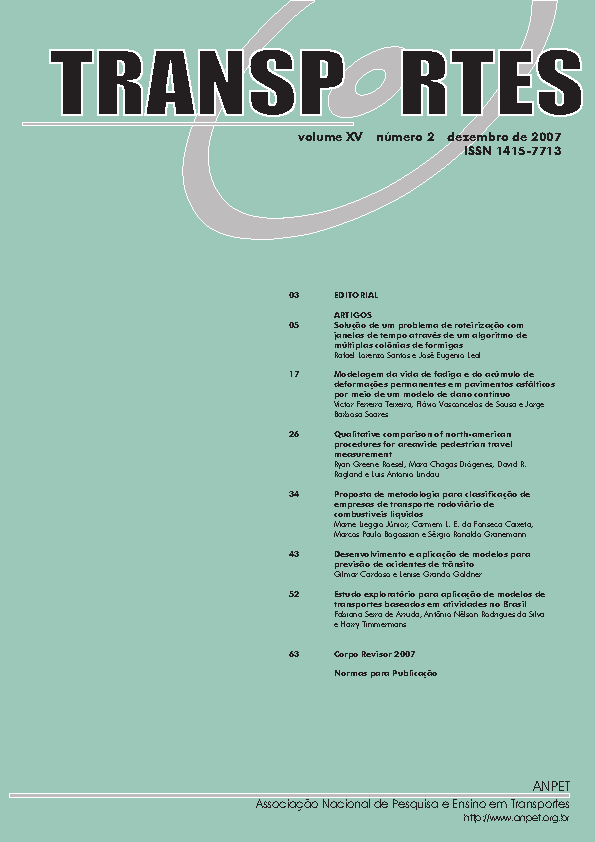Modelagem da vida de fadiga e do acúmulo de deformações permanentes em pavimentos asfálticos por meio de um modelo de dano contínuo
DOI:
https://doi.org/10.14295/transportes.v15i2.32Abstract
É sabido que as condições das rodovias brasileiras têm grande impacto sobre a economia nacional. Diante disso, nasce a necessidade de uma busca por métodos de análise de pavimentos que possam prever com maior precisão as falhas as quais o pavimento está submetido. Dentre os principais métodos utilizados atualmente, pode-se citar os métodos puramente empíricos e aqueles mecanístico-empíricos que fazem uso da resposta estrutural do pavimento. A aprimoração de técnicas numéricas como o Método dos Elementos Finitos (MEF) ou o Método dos Elementos de Contorno (MEC) tem feito com que os métodos mecanístico-empíricos ganhem cada vez mais espaço e sejam mais usados no dimensionamento de pavimentos. O presente trabalho apresenta um modelo mecanístico que considera a evolução do dano causado pelos carregamentos e, conseqüentemente, possibilita uma melhor simulação da vida de fadiga da camada asfáltica. O modelo também possibilita uma melhor modelagem do acúmulo de deformação permanente nos pavimentos através do uso da Teoria da Viscoelasticidade, permitindo assim avaliar as duas principais falhas dos pavimentos flexíveis.
Downloads
Downloads
Published
How to Cite
Issue
Section
License
Authors who submit papers for publication by TRANSPORTES agree to the following terms:
- The authors retain the copyright and grant Transportes the right of first publication of the manuscript, without any financial charge, and waive any other remuneration for its publication by ANPET.
- Upon publication by Transportes, the manuscript is automatically licensed under the Creative Commons License CC BY 4.0 license. This license permits the work to be shared with proper attribution to the authors and its original publication in this journal, and to be adapted for non-commercial purposes, provided appropriate credit is given and any derivative works are distributed under the same terms.
- Authors are authorized to enter into additional separate contracts for the non-exclusive distribution of the version of the manuscript published in this journal (e.g., publishing in an institutional repository or as a book chapter), with recognition of the initial publication in this journal, provided that such a contract does not imply an endorsement of the content of the manuscript or the new medium by ANPET.
- Authors are permitted and encouraged to publish and distribute their work online (e.g., in institutional repositories or on their personal websites) after the editorial process is complete. As Transportes provides open access to all published issues, authors are encouraged to use links to the DOI of their article in these cases.
- Authors guarantee that they have obtained the necessary authorization from their employers for the transfer of rights under this agreement, if these employers hold any copyright over the manuscript. Additionally, authors assume all responsibility for any copyright infringements by these employers, releasing ANPET and Transportes from any responsibility in this regard.
- Authors assume full responsibility for the content of the manuscript, including the necessary and appropriate authorizations for the disclosure of collected data and obtained results, releasing ANPET and Transportes from any responsibility in this regard.









